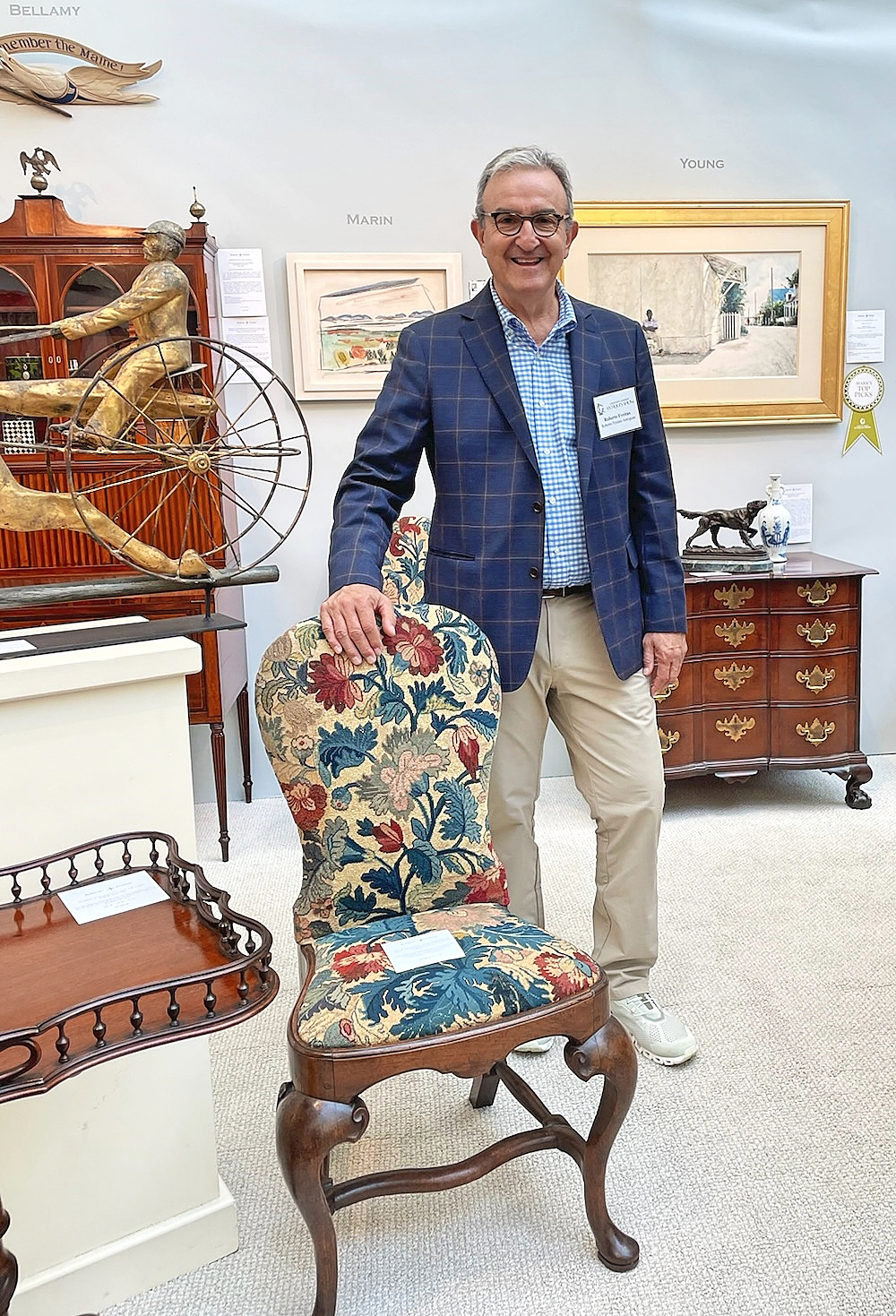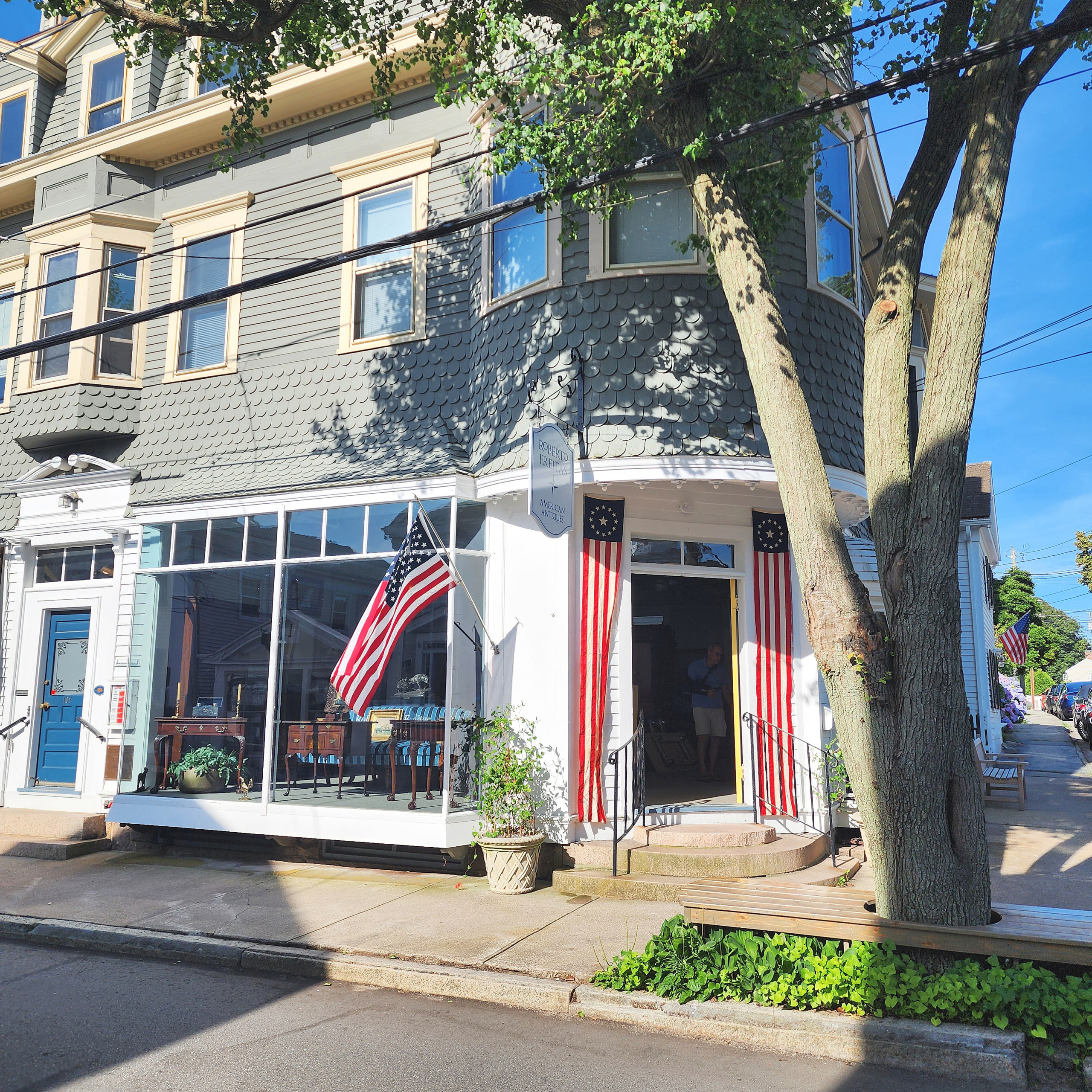
Roberto Freitas in his booth at the Lauritzen Garden Antiques Show.
Among the “Kings of Americana,” dealer Roberto Freitas of Stonington, Conn., is a hard-working, independent practitioner with an enviable collection of period American furniture of the Eighteenth and Nineteenth Century, complemented by folk art, fine art and decorative arts. This past summer, Freitas moved into a gallery at the historic James Merrill House on 107 Water Street in Stonington Borough. It’s a beautiful late-Victorian commercial/residential block in a quaint maritime village perched on a narrow peninsula in the southeastern corner of Connecticut. The house has a close association with American poet James Ingram Merrill (1926-1995), having drawn leading intellectuals and cultural figures of the day and was the place where Merrill produced virtually all of his major writing. Antiques and The Arts Weekly asked Freitas, who was at work on the show circuit, what was behind his move into the eclectically styled, shingle-clad building, and he took time to answer our questions via email.
When and why did you move your gallery?
I moved to the new space in July. The reason for the move was that this new space is considerably larger than my previous location — probably three times more square footage. This new space allows me to showcase all of my inventory, whereas before, I had two storage units in addition to my gallery space.
You’re a busy exhibitor. How can folks visit the new gallery?
My regular hours are Wednesday through Monday from 10 am to 4 pm. However, while I’m away at shows, the gallery has reduced hours: Friday through Sunday, or by appointment.
Where are you now?
In Omaha, Neb., at the Lauritzen Gardens Antiques Show.
Tell us about your early years before your 30-year career in the antiques trade.
I was born in Brazil and came to America with my parents at age 11. I was primarily raised by my grandmother, while both my parents worked two to three jobs to earn enough to give me and my brother, who was born here, a better life. I think that’s where I got my work ethic from. I grew up watching them work third-shift factory jobs, then come home to get ready for their daytime jobs in housekeeping and gardening, respectively. I have many wonderful memories from Brazil, but I also remember that we lived in a poor neighborhood, with lots of crime. They sacrificed so much just to make sure I would have a better life. I am very grateful for that.
How many shows do you do a year?
Twelve.
What was your path to becoming an antiques dealer, and why, in particular, a dealer specializing in Americana?
As a kid, I remember riding my bike in Stonington Borough, and a local dealer called me over and said, “Hey kid, help me move a piece of furniture!” I did, and he paid me $10 — that was a lot of money for a kid back then. Later, when I had my driver’s license, I would help drive this dealer, Neil Eustace, to shows, and help him set up. Fast forward a couple of decades, I started working for Marguerite Riordan, who also had a large gallery in Stonington Borough. I did a lot of the heavy lifting, moving in and setting up at the Winter Show in New York. She was incredibly knowledgeable and had a great eye. She taught me a lot. Later on, as I needed more hours, I started supplementing with per diem work at Northeast Auctions, and later I worked for Washington, DC, dealer, Guy Bush, until 2002 when I decided to try it on my own. Having had primarily worked with Americana dealers, I developed a passion for American antiques, “brown furniture.”
I started out dealing in American furniture and used art to help “prop” the furniture. As the market for “brown furniture” slowly halted, it was the art that kept my business going. So it happened very organically that today I carry a mix of both antique furniture and art.

Freitas’ gallery is located at the historic James Merrill House on 107 Water Street in Stonington Borough.
Who were your mentors or inspirational figures?
Albert Sack. I remember working at Northeast Auctions, and Albert Sack was there to preview some items. I asked him if he would allow me to walk with him to observe, which he allowed. I also asked him to “think out loud.” I learned a lot that way, not just from Albert Sack, but also from other dealers and scholars. I was never shy to ask, and most people are happy to share their knowledge, especially when it’s something they are passionate about.
You have sold to major collections and museums. What has been the highest price sale or most notable item that you’ve sold to date?
A Townsend-Goddard Newport kneehole desk. I brokered a deal between Albert Sack and a collector. I can’t share what I sold it for, but I can tell you that when the wire payment arrived in my account, my bank called and said they thought there had been a mistake, one too many zeros. It was not a mistake.
Tell us about the one that got away, or what is your ‘Holy Grail’ to add to your collection?
A Newport tea table with open talons, offered at Sotheby’s. Albert Sack got it for $7.4 million, I was the underbidder. Although I didn’t get it, I definitely got noticed, and I think that was what put me on the map as a serious dealer.
You have a notable selection of marine art in your collection. Why is that?
Maybe because I live in a coastal town. Marine art is just naturally appealing, the landscape aspect of a great artist’s execution of the water and the sky above it, combined with the story behind the vessel depicted. It’s interesting.
Do you have a personal favorite style in period furniture?
Queen Anne — I like the form, the lines, of Queen Anne furniture, there is a simple elegance to it.
The San Francisco Fall Show recently opened. What is a favorite restaurant or nightspot when you’re in town?
I like to explore new places, so my answer keeps changing. I do like Fiorella on Polk Street, to name one.
—W.A. Demers




